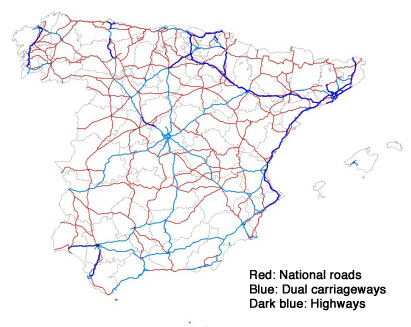Substantial investments have been made in Spain’s transport infrastructure. Teresa Garcia-Milà and José G. Montalvo investigate the effect of highway construction between 1984-2000 on job creation and business creation, not finding a convincing impact.
On the impact of public transport infrastructure
Whenever a recession is looming over a country voices emerge that call for public investment in infrastructure to reanimate the economy and improve competitiveness. So far little convincing empirical evidence on the effectiveness and efficiency of public transport infrastructure has been provided. Most estimates date back to the end of the 80s and the beginning of the 90s. Using a broad brush they find extremely large estimates, which are still used to justify large-scale public investments by the World Bank and the European Union, amongst others.
The rationale behind investments in transport infrastructure
Why might an improvement in transport infrastructure translate into economic growth? Better transport connections can make areas of lower economic activity more attractive for firm location (to gain access to market in core areas) but, at the same time, competition from firms in economic agglomerations may increase as they can now more easily supply locations at a distance, and benefit from cost and demand linkages. Teresa Garcia-Milà and José G. Montalvo use a fine-grained approach in their BSE Working Paper (No. 754) to measure the impact of highways on business location and job creation in Spain.
The empirical approach
Instead of using aggregate production functions they focus on the exact location of new firms and the employment generated by dividing highways into rectangles of 20km length and 10km width. In order to account for the fact that areas, where highways are constructed, might not be chosen randomly, the authors use matching techniques. Thereby, their empirical estimation is comparing the difference in the number of new establishments, or employment, in the vicinity of segments transformed into highways/dual carriageways versus a similar segment where this investment has not been carried out. The similarity of municipalities is determined on the basis of demographics, labor market characteristics, sectoral mix, and education.
The results suggest meager effects
Garcia-Milà and Montalvo look at changes in highways in Spain during 1984-2000, a period with large infrastructure investment. While in 1984 Spain had 2,286km of highways and dual carriageways, in 2000 that number had increased to 10,443km, the major part of the change being an upgrade of national roads to high capacity roads.The Spanish system of national roads and highways in 2000 is exhibited in the Figure below. The authors find that transforming a national road into a highway creates between 350 and 480 jobs per ten square kilometer more than similar areas that did not benefit from the infrastructure intervention. However, the estimates are insignificant. Given that it might take time for the impact to be realized, the authors only look at transformations that took place before 1994. Again the results are insignificant, suggesting the creation of 24 to 54 firms and 300 to 760 jobs.

Why might the impact not have been greater?
Why are the authors not finding significant impacts? Many of the roads transformed were financed by the European Structural Funds (ESF) allocated to Spain, which mostly had to be directed to less developed regions. Therefore, the decisions of which roads to upgrade were not solely based on economic considerations. The lack of economic consideration could have been magnified by “pork barrel” politics, meaning that politicians might cater to specific regions to swing voters in their favor.


